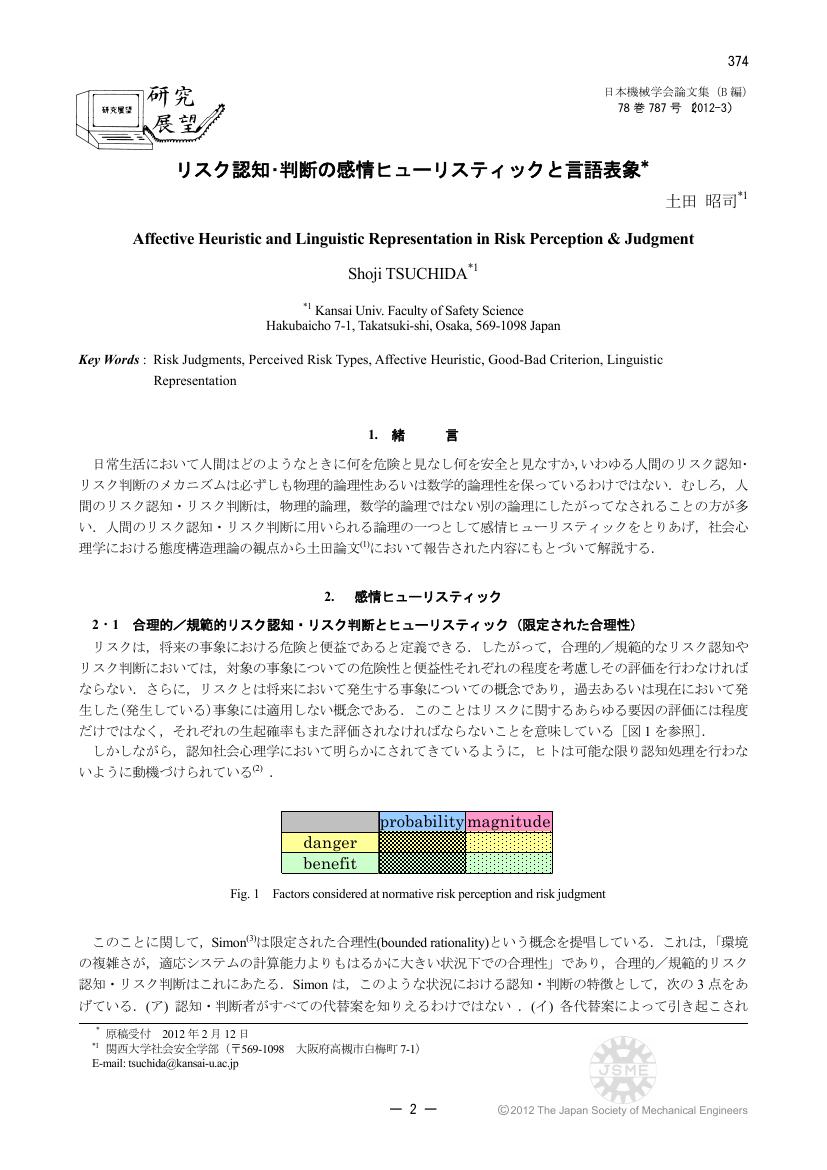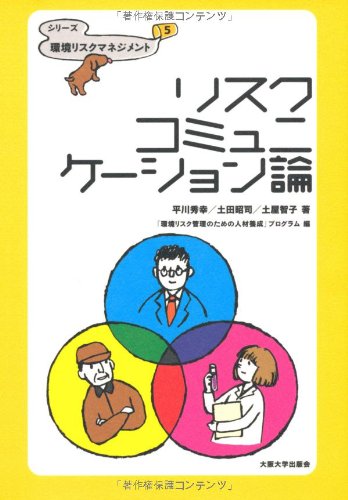16 0 0 0 OA 福島復興に向けた「風評被害」への対応 春の年会での理事会セッション
- 著者
- 寿楽浩太 土田 昭司 下 道國 神里 達博
- 出版者
- 一般社団法人 日本原子力学会
- 雑誌
- 日本原子力学会誌ATOMOΣ (ISSN:18822606)
- 巻号頁・発行日
- vol.60, no.9, pp.542-548, 2018 (Released:2020-04-02)
東京電力福島第一原子力発電所事故から7年。福島県の農畜産物の価格が,事故前の水準に戻らない。風評被害はなぜ,起こるのか。この問題にはどう対処すればいいのか。原子力学会の理事会と社会環境部会は春の年会でこれをテーマにしたセッションを企画し,この問題に対する解決策を探った。ここでは登壇した4人の講演と,その後の質疑の概要を紹介する。
- 著者
- 塩谷 尚正 中原 洪二郎 土田 昭司
- 出版者
- 日本社会心理学会
- 雑誌
- 社会心理学研究 (ISSN:09161503)
- 巻号頁・発行日
- vol.29, no.2, pp.113-119, 2013
Previous studies have shown the positive effects of collective efficacy on community collective actions. As a predictor of collective efficacy, while behavioral social connectedness has shown a positive effect in some studies, the effect of cognitive social connectedness is little known. In this study, the perceived intragroup relationship (Yuki, 2003) was applied in order to investigate the relation among perceived intragroup relationship, collective efficacy, and the intention of participating in community development. We distributed questionnaires to 500 citizens and analyzed data that were collected from 121 respondents. The result of correlation analysis showed a positive relation among the intention of participating, collective efficacy, intragroup relational cognition, and behavioral social connectedness. Furthermore, a determinate process model of the intention to participate was examined using path analysis. The results indicate that perceived intragroup relationship has a positive correlation with social connectedness behavior and a positive effect on collective efficacy, but social connectedness behavior does not have a significant effect on collective efficacy.
5 0 0 0 OA リスク認知・判断の感情ヒューリスティックと言語表象
- 著者
- 土田 昭司
- 出版者
- 一般社団法人 日本機械学会
- 雑誌
- 日本機械学会論文集B編 (ISSN:18848346)
- 巻号頁・発行日
- vol.78, no.787, pp.374-383, 2012 (Released:2012-03-25)
- 参考文献数
- 16
4 0 0 0 OA エネルギーと原子力に関する定期意識調査(首都圏住民)
- 著者
- 篠田 佳彦 土田 昭司 木村 浩
- 出版者
- 一般社団法人 日本原子力学会
- 雑誌
- 日本原子力学会和文論文誌 (ISSN:13472879)
- 巻号頁・発行日
- vol.13, no.3, pp.94-112, 2014 (Released:2014-08-15)
- 参考文献数
- 19
- 被引用文献数
- 1 2
Fukushima Daiichi nuclear power plant accident (Fukushima accident) has brought about a great change in many people's perceptions about nuclear power plant safety. When discussing future energy options for Japan, it is important to have a full grasp of the attitude of a large number of people towards nuclear energy. The Atomic Energy Society of Japan has conducted annual questionnaire survey of 500 adults who live within 30 kilometers of Tokyo Station. The aim of this survey is to assess trends in public attitude towards nuclear energy. The authors that designed the questionnaire entries of this survey have been managing questionnaire data as members of the Data Management Working Group under the Social and Environmental Division of the Atomic Energy Society of Japan. We confirmed the change in public attitude towards nuclear energy through this periodical survey after the Fukushima accident. In particular, public concerns about the use of nuclear energy increased after the Fukushima accident, and many people have raised doubts over the use of nuclear energy in the future.
2 0 0 0 OA リスク認知・リスク判断は感情か理性か:リスクコミュニケーションにおける訴求効果
- 著者
- 土田 昭司 木下 冨雄 中谷内 一也 田中 豊
- 出版者
- The Society for Risk Analysis, Japan
- 雑誌
- 日本リスク研究学会誌 (ISSN:09155465)
- 巻号頁・発行日
- vol.19, no.2, pp.2_45-2_55, 2009 (Released:2012-03-09)
- 参考文献数
- 11
2 0 0 0 リスクコミュニケーション論
- 著者
- 平川秀幸 土田昭司 土屋智子著 「環境リスク管理のための人材養成」プログラム編
- 出版者
- 大阪大学出版会
- 巻号頁・発行日
- 2011
1 0 0 0 OA 新型コロナウイルス感染症流行対策に対する2020年8月までの市民の対応
- 著者
- 土田 昭司 元吉 忠寛 近藤 誠司 静間 健人 浦山 郁 小村 佳代
- 出版者
- 一般社団法人 日本リスク学会
- 雑誌
- リスク学研究 (ISSN:24358428)
- 巻号頁・発行日
- vol.31, no.2, pp.79-88, 2021-12-25 (Released:2021-12-17)
- 参考文献数
- 25
Response of the Japanese to COVID-19 was investigated with 2 online questionnaire surveys conducted on May 2020 [N=1,200] and on August 2020 [N=6,000]. The results showed that high anxiety led sense of discrimination and adopting prevention behaviors against infection. People in metropolitan areas seemed estimating infection risk of long rage transport lower than people in rural areas. And response to Covid-19 of the Japanese residing outside of Japan was investigated with an online survey on August 2020 [N=116]. The results showed that in many countries the respondents answered that their local governments’ policies against COVID-19 were better than the Japanese policy because of swiftness, leadership, public relations, ICT use, and so on.
1 0 0 0 IR リスク認知・判断についての社会心理学的一考察 : 消費行動への適用も視野に入れて
- 著者
- 土田 昭司
- 出版者
- 関西大学経済・政治研究所
- 雑誌
- セミナー年報 (ISSN:18822010)
- 巻号頁・発行日
- no.2008, pp.129-138, 2009-03-31
第183回公開講座
- 著者
- 土田 昭司
- 出版者
- 関西大学経済・政治研究所
- 雑誌
- セミナー年報 (ISSN:18822010)
- 巻号頁・発行日
- vol.2008, pp.129-138, 2008
- 著者
- 塩谷 尚正 中原 洪二郎 土田 昭司
- 出版者
- 日本社会心理学会
- 雑誌
- 社会心理学研究 (ISSN:09161503)
- 巻号頁・発行日
- vol.29, no.2, pp.113-119, 2013-11-30 (Released:2017-02-27)
Previous studies have shown the positive effects of collective efficacy on community collective actions. As a predictor of collective efficacy, while behavioral social connectedness has shown a positive effect in some studies, the effect of cognitive social connectedness is little known. In this study, the perceived intragroup relationship (Yuki, 2003) was applied in order to investigate the relation among perceived intragroup relationship, collective efficacy, and the intention of participating in community development. We distributed questionnaires to 500 citizens and analyzed data that were collected from 121 respondents. The result of correlation analysis showed a positive relation among the intention of participating, collective efficacy, intragroup relational cognition, and behavioral social connectedness. Furthermore, a determinate process model of the intention to participate was examined using path analysis. The results indicate that perceived intragroup relationship has a positive correlation with social connectedness behavior and a positive effect on collective efficacy, but social connectedness behavior does not have a significant effect on collective efficacy.
1 0 0 0 OA 対象について考えることが社会的判断におよぼす効果
- 著者
- 土田 昭司
- 出版者
- 公益社団法人 日本心理学会
- 雑誌
- 心理学研究 (ISSN:00215236)
- 巻号頁・発行日
- vol.55, no.6, pp.356-361, 1985-02-28 (Released:2010-07-16)
- 参考文献数
- 22
- 被引用文献数
- 1
The present study examined effects of thinking on social judgment. The following two hypotheses were tested: (1) The subjects who thought about a stimulus person would judge statements concerning the person with smaller latitude of acceptance, with larger latitude of rejection, and with smaller latitude of noncommitment than the subjects who were distracted from thinking. (2) The subjects who thought about the stimulus person would spend less time to form the judgments above than the subjects who were distracted from thinking. Twenty-four male undergraduates watched a video-tape which showed a stimulus person. Half of the subjects were instructed to think about the stimulus person for two minutes. The other half of the subjects were distracted from thinking for two minutes. Nine statements which described the behavioral intentions toward the stimulus person were displayed on a screen of a micro-computer. The subjects first judged whether the statements were acceptable, and then judged whether the statements were rejectable. Their judgments and the response time which they spent to judge were measured. The results supported both of the hypotheses.


